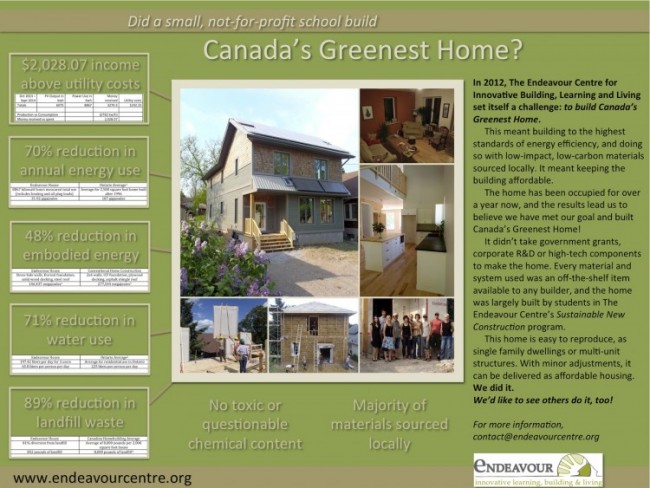In 2012, we had a vision of creating a spec-home on an urban infill lot in central Peterborough, a home that would aspire to the very highest standards of sustainable building while also achieving a modern aesthetic that would appeal to a wide range of potential homeowners. We also wanted to build the home in a way that could be easily reproduced by any conventional contractor.
One of our key goals was to ensure that we weren’t just promising improved environmental performance, but that we were achieving measurable results. Having occupied the home for just over a year, we have now had a chance to monitor its performance and calculate a variety of metrics, comparing these to the more conventional homes that share the marketplace. We couldn’t be more pleased with the results, as summarized in the graphic above.
While the performance of the house marks a vast improvement over current practices, perhaps the most remarkable aspect is that this level of performance was not difficult to achieve. Any builder can hit this standard of performance, and do so within the cost range that is currently acceptable in the market. While this project made some more costly investments in PV, rainwater harvesting, composting toilets and solar hot water, a home built to the same level of performance without these “add-ons” would be entirely cost-competitive. And other than the solar income, most of the metrics above would not change if we didn’t invest in these technologies.
Literally anybody can do this type of building, and do it affordably. We intentionally chose to buy off-the-shelf or easily accessible materials and products, from Durisol foundation blocks to prefabricated straw bale wall panels to ready-made clay and lime paints. Everything in this home is available to builders, and every builder already has the skills to create something like this.
This feels like good news when we’re faced with an onslaught of doom-and-gloom news about the environment. Not that this home will save the planet, but when it comes to easily achieved results that have dramatic reductions in impact, the reproduction of homes like this could be a remarkable step in the right direction. Government forecasts show that the US expects about 1,000,000 new home starts per month in 2015, and Canada expects about 190,000. If all of those homes reduced their energy use by the same amount as this project, that would be 89,250,000 gigajoules of energy savings, 189,210,000 liters of water saved, and 156,017,330 gigajoules of saved embodied energy. Those are meaningful numbers (the equivalent of the output of many nuclear generating stations!), and they are immediately achievable.
When we called this project “Canada’s Greenest Home” we were not trying to set an example that would set an untouchable record for green performance. Instead, we were trying to set a standard that would be inspirational in its final performance and entirely reproducible, so that every new home could easily be this green. We feel we’ve achieved this goal. The rest is now up to home owners, home builders and governments to take this example and adopt and improve it.
